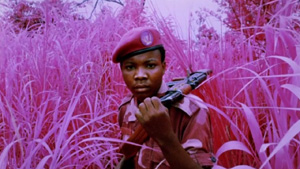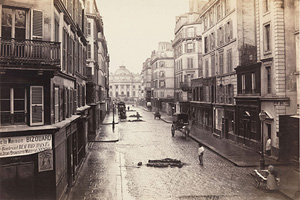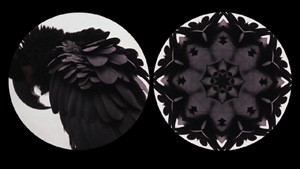Fast Art
John Haberin New York City
The 2014 New York Art Fairs I
For once, let me put in a plug for fast art. No, not the opposite of "slow art," the kind that rewards long, slow looking. And no, not art that plays fast and loose with the present, although there is a time and place for that, too.
But no, how about art that stands up to someone practically running away? Art almost has to, if it is to survive the 2014 art fairs. On a weekend in early March, one could take in as many as ten art fairs or, in one case, a self-proclaimed "anti-art fair"—with Frieze, NADA, and more still to come in May. One could, that is, if one managed ever to leave the Armory Show, with its hundreds of booths along two piers and three city blocks by the Hudson. One evening, a bus waited there, too, to lure the willing to galleries in Bushwick. What then is left to see or to say—and who but I would tell you about it all? 
What is left to see
The year before, 2013, demanded that one ask. It was the hundredth anniversary of the original Armory Show, the one that brought Modernism to America, and one could only wonder what has been lost. Yet each year, my report (now in its seventh edition) has to raise much the same questions. Art fairs highlight the commercial pressures facing all galleries and artists, with the midlevel dealers that offer the greatest hope for change obliged, as with "virtual exhibitions" or cautious reopenings after Covid-19, to shell out more than many are likely to gain. The perpetual fairs also threaten to reduce art to a stifling sameness. With so many this year spread out across the city, has March finally brought Miami-Basel to Manhattan?
Actually, the problem may be quite the opposite of what those questions suggest, and so may the opportunities. One hundred years after the shock of the new, uniformity and the avant-garde have in fact given way to diversity and drift. I have already quarreled with "slow art," as sloganeering that misses out on just that. So let me once again run down the differences, starting with the competitor that claims to say it all. As in the mocking photographs of Andy Freeberg, the Armory Show looks very much like a long day in New York galleries, give or take all the others. Who would have time to stop and look?
Once again, the vast fair has one pier for modern art, the other (and much of the connecting block) for contemporary art. Living artists in the first, like Frank Stella, may wonder if they are no longer contemporary. Postmodernists in both like Julian Opie may positively gloat at their status. Once again, too, with its breaks for lounges and upscale eateries, the Armory Show wants to be a world apart from the very scene it recognizes. And once again it has occasional installations, like a "library" of mostly empty boxes by Liu Wei. This time, though, it is trying just a wee bit to reach out.
It has a mostly forgettable aisle for China (with a capital C), and token attention to women, curated by Susan Harris. While this means just four alcoves, one of drawings hung Salon style with labels hard to match with the art, it does bring together cast paper from 1980 by Lynda Benglis, in a row of color ascending to the sky. It also has a stunningly simple wall painting by Pat Steir, a single calligraphic brushstroke in white. For the first time, the fair also ends with an alcove for newer galleries, each with just one or two artists. With Higher Pictures, make that a single work, Travis Smiley's dark and glowing abstraction drawn in Photoshop, multiplied, printed, scanned—and then all of the above over and over again.
This being the Armory Show, "newer" means anything under ten years, and it comes at the end of a pier, next to, appropriately enough, Mile End Deli. Still, it is a start, and by then one will have seen impressive art. Can any of it still startle? One can always marvel at how much of early Modernism is still out there, as with a booth just for Giorgio Morandi, including early Morandi but has one then succumbed entirely to the market? The litany looks great all the same. I learned how Conrad Marca-Relli (with Hackett-Mill) took a razor blade to Abstract Expressionism in glorious red, while LA geometric abstraction (with Louis Stern), including Karl Benjamin and Helen Lundeberg, will have me thinking again.
Naturally large work often stands out the most. That could be a lush infrared photograph by Richard Mosse (with Jack Shainman), or an operatic racial history in black and white by Kara Walker (with Sikkema-Jenkins). It could be black beams running every which way from floor to ceiling by Serge Alain Nitegeka, a South African artist (with Marianne Boesky), as both obstacle and invitation to his paintings. Still, this is fast art, even if it takes four hours. It should have one longing for one of the nine alternatives. And oddly enough the most sedate of them holds the most surprises.
A nudge toward art
The ADAA Art Show still has the Park Avenue Armory that the Armory Show has left behind, and it still has relatively quiet evenings and costly art. This year, though, some of it did startle me. Single-artist displays include Irving Penn nudes (with Pace) and a worthy boast of Paula Modersohn-Becker (with Galerie St. Etienne) as "the first woman modernist." They contrast views of Paris by Gustave Le Gray and Charles Marville (with Hans Kraus) and allow Petah Coyne (with Galerie Lelong) to remake a fair booth with artificial flowers. Lee Krasner (with Robert Miller) fragments her work here to the point of Krasner in collage, all the more daring and contemporary just a few booths away from Dana Schutz (with Petzel). And who knew that Ad Reinhardt (with David Zwirner) executed just six of his black paintings on paper—and that one could still see them all?
 Credit the nudge toward single artists and insight to Volta. From the first, that fair has insisted on single-artist booths, with an artist's name notably larger than the gallery's, bringing curating to commerce so well that one early critic saw a conflict of interest! It has also grown tackier and tackier in recent years, but a move to Soho helps to reverse the trend. It brings less glitz and more painting, perhaps an acknowledgment that booths are rarely all that conducive to video, performance, or even sculpture (and do allow me to say no more about the naked man dressing up in paper bags). Willie Cole (with beta pictoris / Maus Contemporary) makes a notable exception, with both painting and sculpture summing up his imagery of scalding irons and shoe fetishes, his concerns for African American history, and his career. Still, this year Volta's heart belongs to abstraction, like tape and canvas collage from Cullen Washington (with Jack Bell), the colorful diamond grids of Biggs and Collins (with Vigo), an evolving color spectrum of monochrome canvas by Siri Berg (with Hionas and now in her nineties!), or the poetry and approach to landscape of Jennifer Wynne Reeves (with BravinLee), in some of her largest work to date.
Credit the nudge toward single artists and insight to Volta. From the first, that fair has insisted on single-artist booths, with an artist's name notably larger than the gallery's, bringing curating to commerce so well that one early critic saw a conflict of interest! It has also grown tackier and tackier in recent years, but a move to Soho helps to reverse the trend. It brings less glitz and more painting, perhaps an acknowledgment that booths are rarely all that conducive to video, performance, or even sculpture (and do allow me to say no more about the naked man dressing up in paper bags). Willie Cole (with beta pictoris / Maus Contemporary) makes a notable exception, with both painting and sculpture summing up his imagery of scalding irons and shoe fetishes, his concerns for African American history, and his career. Still, this year Volta's heart belongs to abstraction, like tape and canvas collage from Cullen Washington (with Jack Bell), the colorful diamond grids of Biggs and Collins (with Vigo), an evolving color spectrum of monochrome canvas by Siri Berg (with Hionas and now in her nineties!), or the poetry and approach to landscape of Jennifer Wynne Reeves (with BravinLee), in some of her largest work to date.
I counted seven Lower East Side galleries and two from Bushwick, but had I escaped the global art scene? Matthew Conradt (with Muriel Guépin) appropriates images of America that, movingly, indeed evoke an older world. Yet the fair that most positions itself as an alternative also conforms most closely to the image of a single, inescapable style of art. It is also a special favorite of art hipsters, most of whom seem to be heading as fast as they can to the rooftop bar. Probably every one of them knows that this building housed the former Dia:Chelsea. And it calls itself the Independent.
It has a point. Exhibitors number more than one nonprofit, although one might never notice. Artists from Berlin to South America blend one into the next, in an open layout with barely a label in sight, beyond a sign for the bathrooms. The result is a leveling, abetted by an almost uniform preference for small objects and smooth surfaces. Alice Mackler (with Kerry Schuss), still an outsider in her eighties, looked so scrappy just the week before on the Lower East Side, and here she becomes downright elegant. Meanwhile the high end lowers itself into the scene.
Is there any alternative? For those unable to settle for open studios, a small and undistinguished group passes itself off as that anti-fair, Clio. And with its usual inclusiveness and condescension, the Bruce High Quality Foundation promises the last Brucennial. Its exhibition in the Meatpacking District included seven hundred artists, all no doubt painstakingly selected—and all of them women. Rumor quickly circulated that men were sneaking in under the radar, but as a stunt or sheer desperation? Either way, the only thing that separates them from the Brucennial is gender.
In all fairness, women in art deserve more attention everywhere, and the cast runs to several dozen of the best, some of their names misspelled in pencil on the crowded walls. Diana Kingsley, Ida Applebroog, Rochelle Feinstein, Lucy Liu, Marilyn Minter, Minter in retrospective, Judy Chicago, Joy Garnett, Betty Tompkins, Katherine Bernhardt and her used junk, Gwyneth Leech, Joanne Greenbaum—at some point I had to stop taking notes. Yet ask yourself: is this how you would wish to be displayed and judged? And is that what you would wish for contemporary art? I thought not, but sadly two other alternatives do far worse.
Peeking in
Neither looks pretty from the moment one enters. Scope has the floor beneath the old Farley Post Office on Eighth Avenue, but nothing of its majestic architecture beyond ventilation ducts. Fountain has the site of the original Armory Show on Lexington Avenue, but parts of it barren and in shadows. One runs to cartoons and other suggestive and superficial gestures, the other to glitz and to pandering better suited to a framing store—like an image of the Beatles formed from their lyrics. Fountain has (disclaimer) friends of mine making a game show, amid its unaffiliated curators and self-promoting artists. Neither holds out an alternative future for art.
And yet there are alternatives, one of them an art fair and the other brand new. Moving Image again steps in where other halfway sane exhibitors fear to tread. Video may get lost in a fair booth, but not in the Tunnel space west of Eleventh Avenue in Chelsea. The fair is too big for a medium that, quite literally, takes time, and it has its omissions. It precludes video as installation, and it plays down new media as object or experiment—although Nam June Paik (thanks to Schroeder Romero, Mixed Greens, and Pavel Zoubok) finds his way in. Extended narratives, whether personal or political, seem unduly labored, like Tion Ang's "Greek tragedy" (with Lynch Tham) as emotive therapy. More frequently and effectively, the fair's artists reflect the bodily rhythms and sensations of a life. 
They may do so almost abstractly, like Aziz+Cucher (with Gazelli) in a swarm-like "cycle of growth" or Leslie Thornton (with Winkleman) in mandalas of birds and utility towers, Lorna Mills (with Transfer) in shifting fabrics, Jason Salavon (with Mark Moore) in type fonts, and Ray Sweeten (with DataSpace) with pixels. They may do it slowly, like Sini Pelkki (with AV-arrki) with a pan across a garden and Patty Chang (with Creative Capital and Moving Image) with a decomposing beached whale—or frenetically, like Aaron Garber-Maikovska (with Greene) in ASL and Zach Nadar (with Microscope) in a cascade of car commercials. They may do so implicitly, like Nicole Cohen (with Morgan Lehman) with a period room consumed by clouds, or explicitly, like Nicholas and Sheila Pye (with Curator's Office) with people sitting, licking each other's eyes, or peeing in their pants. Once or twice, they may even feel the weight at once of political and human bodies. Oded Hirsch pushes his father in a wheelchair to the shores of Galilee, across unwelcoming terrain, while Jhafis Quintero (with Analix Forever) enacts ten years in jail by pacing back and forth down a narrow prison corridor. Moving images can have greater immediacy than this, but not greater urgency for their artists and subjects.
The new art show is not exactly a fair, but it is sure an alternative. Its location, a former school for boys in Nolita, even recalls when P.S. 1 was an alternative space, before it was swallowed up as MoMA PS1. Spring/Break calls itself a "curator-driven art fair," and every room has a curator. It is less a fair, though, than forty solo and group shows. It also works better than other alternatives—not solely on account of the curating, but also because it approaches a single, compelling installation. It is about not just walking into a schoolhouse, but prying into its secrets. When Jamie Diamond calls a photograph Staged Voyeurism, she could be speaking for everyone.
They fill one dark chamber after another, with blackboards intact, pulsing soundtracks, and no end of exposed bodies. One can peer into classrooms, coat rooms, stairwells, and bathrooms, where Eve Sussman and Simon Lee have stuffed the urinals. One can peer into office and apartment windows with Diamond and Sussman, into a bedroom with Jennifer and Kevin McCoy, or into the car of a "private drive-in" with Will Bates and Sarah Bereza, for a guilty appraisal of the lives within. One can allow others to peer into one's own secrets as well. I took a lie detector test for Scott Avery (aka Amani Olu, the alleged curator), as a measure of the "integrity and character of the art world." Judging by the questions about sexual habits and politics, its integrity and character are not good.
The show has at least the expected amount of dreck and leading questions—and so, the long weekend and the 2014 Whitney Biennial make clear, does contemporary art. Is it enough to escape into the not so contemporary, like so much of the leading fairs, or is it enough to fend for oneself? Evidently neither, and I can only ask for no more art fairs, please, at least until May. I promise myself each year to forget the whole thing, and yet here I was again. Love them or hate them, the fairs still add up to a fair representation of today's wealth and messy creativity alike. If their temptations are both esthetic and commercial, for now they will have to do.

These New York art fairs ran March 5–9, 2014. Another related review turns to a panel discussion of "Art Fairs: An Irresistible Force?" After reporting for seven years in a row now, including Frieze and NADA, plus more than once before that and with the 2015 art fairs, 2016 art fairs, a2017 art fairs, 2018 art fairs, 2019 art fairs, 2020 art fairs, 2021 art fairs, spring 2022 art fairs, fall 2022 art fairs, spring 2023 art fairs, and fall 2023 art fairs to come, including Frieze, Frieze online, Art New York, and NADA.




